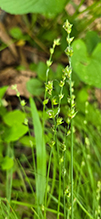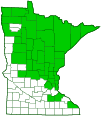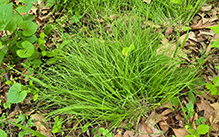brownish sedge
(Carex brunnescens)
Overview • Description • Distribution • Taxonomy
Description |
Brownish sedge forms small, very dense clumps. Within the tuft, each individual plant has a single, unbranched, flowering stem with a cluster of leaves at the base. The flowering stem (culm) is three-angled and 6″ to 36″ (15 to 90 cm) tall. It is usually longer than the leaves. The leaves are restricted to the lower half of the culm. The leaf blade is hairless and usually 4″ to 10″ (10 to 25 cm) long and 1⁄32″ to ⅛″ (1.0 to 2.5 mm) wide, and hairless. The inflorescence at the end of the culm is unbranched and is usually ⅝″ to 2″ (1.5 to 5.0 cm) long. It ihas 5 to 10 groups of flowers (spikes). The two spikes at the tip are closely spaced, the remaining spikes are widely separated. Each spike is stalkless and is subtended by a single modified leaf (bract). The lowest bract is stiff, bristle-like, and very long, but it is not longer than the inflorescence. Each spike is globe-shaped or slightly longer than wide and up to ¼″ (7 mm) long. It usually has 5 to 10 female (pistillate) flowers, but it may have up to 15 or even more. The terminal spike has both male and female flowers, with pistillate (female) flowers at the tip and staminate (male) flowers at the base. It may be club-shaped or ellipse shaped. The staminate base that is not quite as long as the pistillate portion above. Each pistillate flower is entirely enclosed by a sac-like bract (perigynium) and subtended by a single scale. The scale is translucent (hyaline) white on the sides and green with 3 veins in the center. The perigynium is green or brown, 1⁄16″ to ⅛″ (2.0 to 2.5 mm) long, and 1⁄32″ to 1⁄16″ (0.8 to 1.5 mm) wide. It often becomes dark brown with old age. The fruit is a dry, one-seeded capsule (achene). It is much smaller than the perigynium. It matures from early June to early August. |
Distribution |
||
|
Sources |
|
| 6/17/2024 | ||
Taxonomy |
|
Kingdom |
|
Division |
Tracheophyta (Vascular Plants) |
Subdivision |
Spermatophytina (Seed Plants) |
Class |
Liliopsida (Monocots) |
Order |
Poales (grasses, sedges, cattails, and allies) |
Family |
Cyperaceae (sedges) |
Subfamily |
Cyperoideae |
Tribe |
Cariceae |
Genus |
Carex (true sedges) |
Subgenus |
Vignea |
Section |
Glareosae |
This species was formerly treated as a subspecies of Carex canescens (hoary sedge). |
|
Subordinate Taxa |
|
Four subspecies have been described, but only two are widely recognized. The characteristics used to distinguish ssp. alaskana and ssp. pacifica gradually transition to (grade into) those of ssp. brunnescens. |
|
brownish sedge (Carex brunnescens ssp. alaskana) brownish sedge (Carex brunnescens ssp. brunnescens) brownish sedge (Carex brunnescens ssp. pacifica) round-spike brownish sedge (Carex brunnescens ssp. sphaerostachya) |
|
Synonyms |
|
Carex canescens ssp. brunnescens Carex canescens var. brunnescens Carex curta var. brunnescens Carex persoonii Facolos brunnescens Vignea brunnescens |
|
Common Names |
|
brown sedge brownish sedge green bog sedge |
|
Glossary
Achene
A dry, one-chambered, single-seeded seed capsule, formed from a single carpel, with the seed attached to the membranous outer layer (wall) only by the seed stalk; the wall, formed entirely from the wall of the superior ovary, does not split open at maturity, but relies on decay or predation to release the contents.
Culm
The hollow or pithy stem of a grass, sedge, or rush.
Perigynium
In Carex and other closely related sedges, a sac-like or flask-shaped, highly modified bract that surrounds the pistillate flower and later encloses the achene. Plural: perigynia.
Spike
The arrangement of an unbranched, elongated inflorescence with stalkless flowers that mature from the base toward the tip. In Cyperaceae, it also denotes a collection of one or a group of stalkless flowers, each subtended by scales, on a single inflorescence axis.
Visitor Photos |
||
Share your photo of this plant. |
||
This button not working for you? |
||
Luciearl |
||
 |
||
Found several clumps of this in a nearby woodland setting. Quite pretty when looking at it closely. The tiny yellow seeds almost seemed to sparkle. |
||
MinnesotaSeasons.com Photos |
||
|
||
|
||

Slideshows |
|

Visitor Videos |
||
Share your video of this plant. |
||
This button not working for you? |
||
|
Other Videos |
||
|

Visitor Sightings |
||
Report a sighting of this plant. |
||
This button not working for you? |
||
Luciearl |
Location: Lake Shore Found several clumps of this in a nearby woodland setting. Quite pretty when looking at it closely. The tiny yellow seeds almost seemed to sparkle. |
MinnesotaSeasons.com Sightings |
||
|

|
Created: 6/19/2024 Last Updated: © MinnesotaSeasons.com. All rights reserved. |

